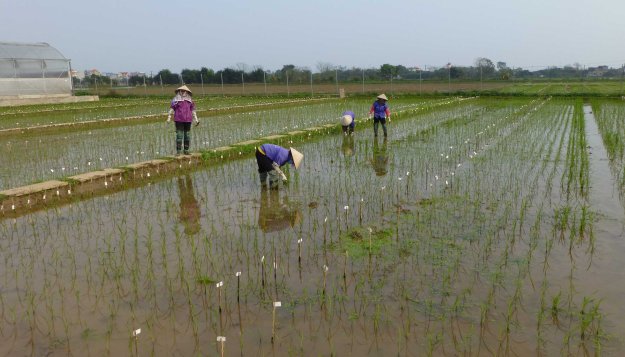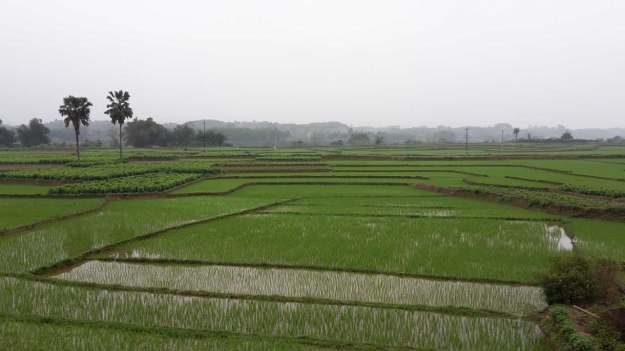 Dr. KeeFui Kon is an agronomist who has led the Syngenta Research & Development (R&D) rice program since 2010. He is working out of Singapore. I used the opportunity of travelling through Singapore to meet with Kon and ask him a few questions about rice.
Dr. KeeFui Kon is an agronomist who has led the Syngenta Research & Development (R&D) rice program since 2010. He is working out of Singapore. I used the opportunity of travelling through Singapore to meet with Kon and ask him a few questions about rice.
Why are you passionate about rice, what is special about that crop?
First of all, rice is a crucial crop for us in Asia. It’s the most important food staple. In South-East Asia, on average people still eat over one kg of rice per person and per week. Nearly 90% of the world’s rice is grown in Asia.
Then, I really like the ‘romantic’ aspect of rice! Rice landscapes are incredibly beautiful, especially the terraces in the hills with water. I love how they change color during the growing season, moving from light green to dark green, then to yellow and finally brown.
From a scientific perspective, rice is a very interesting crop. Because it always has to be in water, there is like a third dimension to it. The element water needs to be considered as part of the ecosystem and this makes it more difficult to study for the scientist, and also more difficult to manage for the farmer. There is still some research that needs to be done to unlock all the secrets of rice, especially combining the different production practices together.
Could you provide a brief overview of the rice growing countries in Asia and how they differ in terms of varieties used and methods of cultivation?
In terms of varieties used, you can roughly divide Asia into three: On the Indian subcontinent, non-glutinous varieties are being grown (the consumers there want ‘loose’ rice); in China, almost only glutinous (= sticky) varieties are being grown (the consumers there eat their rice with chopsticks); and S-E Asia is somewhere in between. The quality of the rice for the consumer is related to taste and smell, which is defined by a set of genes; therefore the quality of the rice is related to the specific varieties that have been bred and selected. In Thailand and Vietnam for example, they tend to grow high-quality rice like the ‘Jasmine’ varieties, whereas in China, yield is more important and nearly half the rice varieties grown are ‘hybrids’. [Like any other hybrid crop, hybrid rice is produced by crossbreeding different kinds of rice, which has the effect of producing more vigorous and higher-yielding offspring.]
The length of the growing season depends very much of the climate. In cooler areas, like in the north of China, Korea and Japan, the growing season is longer to give the plants more time to develop (up to 180 days) and therefore there is only one growing season. In warmer areas, farmers can fit two, or sometimes even three, growing seasons in one year.
In terms of growing method, farmers across Asia have two distinct practices: the transplanted rice method (when rice seedlings are transplanted from the nursery) and the direct seeding method (when the seeds are directly sown in the field). These are roughly at 80/20 proportion and I guess will stay in this ratio for a long time to come.
Can you please keep on talking about the differences in terms of technology used and mechanization for rice cultivation in Asia?
In Asia there are basically three categories of rice farmers: The ones who have not changed or will change very little, with a yield inferior to 3 tons/ha (about 20%). Next, the traditional farmers who manage to reach a yield between 3 and 5 tons/ha (about 60%). And finally, the progressive farmers who obtain a yield higher than 5 tons/ha (about 20%).
The yield very much depends on technology/mechanization. Whereas the farmers in the first category nearly use no technology at all and the ones in the third category make full use of technology, there are more differences in the middle category. Those farmers invest in technology at various levels; if they have the money and the will, they would probably start changing their practices in the following way (in this order):
– Switch from manual to mechanical harvesting, since this is the most labor-demanding task
– Use machines to prepare the soil, since this activity demands a lot of energy when done manually
– Invest in mechanical planting, using a mechanical seeder or transplanter
– Use (more/better) chemicals to fertilize their soil and protect their crops
Let’s talk a bit more about rice yield. The average world yield for rice is 4.5 tons/ha (2012 figure) but for example Australian rice farmers reach yields of over 10 tons/ha, whereas it’s less than 3 tons/ha in Madagascar. Why are there such differences in productivity worldwide
As I said earlier, the yield depends on the rice variety (for example, hybrids have better yields than conventional varieties.) It also depends on the degree of mechanization and the growing practices (for example, when planted with a machine, the seeds are distributed more evenly, they grow more uniformly and can be harvested at the same time, i.e., at the ‘ideal moment’ of 80% of maturity). In addition, it depends on the climate. Even if rice can grow in many different environments, it is quite a fussy crop. To grow at its best it needs the right amount of water, a lot of direct sunshine and an optimum temperature of 20 to 30°C during the ripening phase. Most of these conditions prevail in Australia, where they also have less diseases and pests. On the other hand in the tropics, it can sometimes be too rainy, too cloudy and too hot – and there are over 25 different pests and diseases that can attack rice!
Could you summarize the main focus in rice research nowadays?
A lot of the rice research is in molecular biology and genetics. I would say that the main focus of rice breeders is to develop varieties and hybrids which are as tasty as existing varieties but provide better yield with improved resistance to diseases and pests.
How do you see the future of rice growing in Asia?
I expect a similar development than with agriculture elsewhere, with a consolidation of the sector: There will be less rice farmers; they will farm on bigger holdings of more fields and will achieve higher yields. Overall the production and productivity will continue to increase, but the surface used for planting rice will slightly decrease, especially in marginal rainfall areas where there is competition for water supply with population growth.
————————————————————————————————————-
Some facts about rice

- Rice is the seed of the grasss pecies Oryza sativa (Asian rice) or Oryza glaberrima (African rice). It is a monocot and is normally grown as an annual plant.
- It is the agricultural commodity with the third-highest worldwide production, aftersugarcane and In 2012, the world dedicated 162 million hectares for rice cultivation and the total production was about 738 million tons. The average world farm yield for rice was 4.5 tons per hectare.
- Asian farmers still account for 87% of the world’s total rice production. Biggest rice producers are China, India, and Indonesia. The biggest rice exporting countries are India, Vietnam, Thailand.
- Rice processing: The seeds of the rice plant are first milled using a rice huller to remove the chaff (the outer husks of the grain) – at this point in the process, the product is called brown rice. The milling may continue, removing the bran, i.e., the rest of the husk and the germ, thereby producing white rice. Then white rice may be buffed with glucose or talc powder (often called polished rice, though this term may also refer to white rice in general), parboiled, or processed into flour.
 Name: Vũ Thi Nhan
Name: Vũ Thi Nhan


 Name: Sia Lee
Name: Sia Lee











